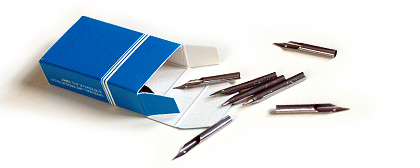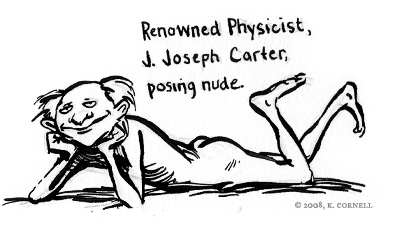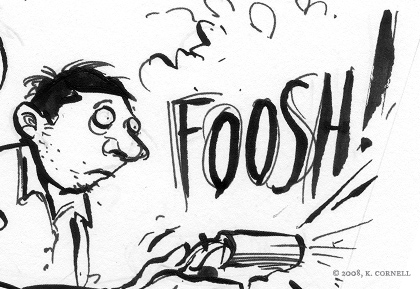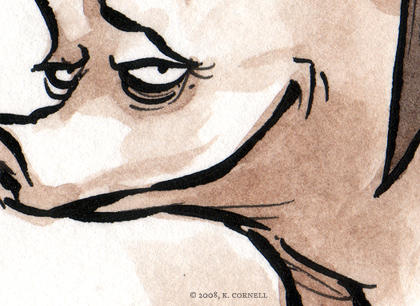The Professional Webspace of Designer and Illustrator Kevin Cornell:
"Design, Art, and Lackluster Humor."
Pen and Ink Drawing Tools
As you may recall, a couple of weeks ago I wrote about the pencils (and other tools of the graphite trade) that I tend to use. This week I'm hoping to answer some of the questions I get regarding Pen & Ink. These are the implements I need to create the kind of linework you'd see in a Six-Penny Anthem, or an Ambidextrous. Or a Mojo Comic. Or for A List Apart. Or in a lot of sketchbook pages. Or for grocery lists and signing credit card receipts.
The Crow Quills For Thee
Here is my Crow Quill pen — a sludge-slickened Speedball #102. Two hundred years ago this would have been just one giant feather with the end split to hold ink. Goose feathers were the most common, but if you wanted really fine lines, you used a crow feather. During the eighteenth century, when wearing wigs and signing Declarations and Constitutions was all in vogue, we killed off all the agreeable crows, the kind that didn't mind just handing over all their feathers. This left us with only the angry kinds of crows, who steal our corn and hang out in murders. So today we manufacture our own pens. That's the price of freedom.
Nibs: Man's Smallest Reservoirs

Now, the real important thing to understand about a Crow Quill pen is that it comes in two parts: the holder, which is where you do all your holding of the pen; and the nib, which is where you do the drawing. The nibs are designed in such a way that when you dip it in ink, it sucks up all that liquid into a little reservoir, where it stays suspended through the magic of surface tension. Then when you want to draw, you press the nib down and it splits just enough so that a trickle of ink runs down onto the page, and — voilà! — you are making a line!
Depending on how much force you use, you can vary the thickness of the line. The nib I prefer, a #102, is generally the most flexible of the Speedball nibs, and so I can usually get a pretty thick line before the end of the nib snaps in half, shooting shards of metal all over my face and arms and eyes and groin. Or, put another way, before the nib bends so much that it no longer holds ink in the reservoir. As you can see from above, I have a whole big box of nibs ready for such situations.
Ink: It's not just for Squids anymore!

Of course, a Crow Quill is completely useless without a bit of ink. To be honest, I've never done any real research into ink; all I look for is that it's black and waterproof. That being said, I've used this Sanford Higgins Waterproof stuff since I was old enough to be accountable for spilling it on the carpet. I don't really pay attention to whether I'm using the normal ink, or the Black Magic brand. There's certainly some difference; judging from the name, I'd say Black Magic is a good stand-in for chicken blood in voodoo ceremonies.
For your viewing pleasure, here's a sample of a drawing made only with a Crow Quill pen:

Truth be told, though, I rarely use the Crow Quill for hatching and adding shadows. The majority of the time I use a single-width pen, like this:
But more on that to come.
Brushing Ink
On numerous occasions, I'll have large areas of black I'll need to fill in on a drawing. There's two ways I can do this: one, I can fill it in digitally, or two, I can use a brush. Option one is usually the way I go when the final product will be digital; but if I'm doing a drawing to hang up on a wall, I'll break out this guy:
This is my angled brush. He's pretty versatile. That tapered tip means I can get into really tight areas, but also make pretty broad, sweeping strokes if I angle it just right. Here's a few cases where I used the angle brush for filling in blacks1:
As you can see, the angle brush can take care of most of my needs. But in certain situations, I may want to letter something, and I'll want a bit more precision. In such cases I'll use a lettering brush:
Its longer bristles act as kind of a "shock absorber", and hide some of the natural jittery-ness that comes with inking, so you get a more controlled line. I used a lettering brush for this bit of onomatopoeia:

That's the sound of a flaregun, kids. Good to know in case someone fires a flaregun and blinds you. Then later, when you hear the foosh, you know someone sent up a flare for help and you can help them.
Micron: The Pen Of Choice
If I didn't mention it already, the Crow Quill can get pretty messy. And what's more, it takes a while to dry. So I actually don't use it near as much as this fellow here:

This is a Sakura Pigma Micron Pen. I've been using these for years now. Chances are if I drew something in pen it was with one of these, and that's because they've got a lot of things going for them. They have a reliable single-width line; they dry relatively fast, and the ink is water-proof and archival. There's also a variety of point-sizes to choose from, so you can get either a really thick or really thin line. I actually prefer to use these for all the hatching I'd do in a Crow Quill drawing. Except for the wanton physicist J. Joseph Carter, all the drawings in this article are hatched with a Micron. Most Mojo comics and every Ambidextrous are drawn with a Micron, for sure.
Not to say they don't have some drawbacks. Microns tend to create a really dark grey line rather than a rich black like the Crow Quill & Higgins Ink combo, and often when I'll use a Micron for hatching on a Crow Quill drawing, the Micron lines almost look brown to me. Also, even though they're waterproof, you can't really do a wash over them (unlike Crow Quill lines, which are pretty steadfast), so if you plan to use microns with a watercolor, you need to do your linework after the watercoloring is done.

But the biggest problem with them is probably that they're expensive, and disposable. I've torn through an estimated 200 in my lifetime. That's a lot of waste. So, much like I'm trying to do with the mechanical pencils, I've switched to a refillable pen, also known as a Rapidograph.
Rapidograph: The New Pen of Choice

I had to buy a set of these in college, though you can purchase them individually. Like I mentioned, these are refillable; you basically unscrew the pen from the holder, and inside is this little cartridge you fill with ink. A nice plus is that rapidograph ink blends into a Crow Quill ink drawing better than a Micron. But a drawback to these babies is that they can clog, so you have to clean them every once in a while. Which is disappointing. I hate cleaning my tools. But then I remind myself that decreasing my environmental impact requires sacrifice. If I can give up ramming beaver dams with my car, what's a little extra cleaning?
A Further Note: Scanning your Blacks
One last thing I'd like to do is give a suggestion for bringing your pen and ink onto the computer. I'll scan almost all of my black and white work as a bitmap (scanners might also call this a "line art" setting), at 600 or sometimes even 1200 dpi. Then, for presentation, I'll convert the image to greyscale and shrink it down to the dimensions and dpi I'd like. You'll notice when you scan your image in at 600 dpi, and it's being displayed at 100%, it's quite pixelated. Well, once you convert to greyscale and shrink the image to at least 300 dpi, those pixelated lines will smooth right up. So there you go.
Next time, installment three: Painting Tools.
Footnotes
1In the case of an A List Apart drawing, I don't use ink to do the wash. I prefer to use watercolor to add tone in an ALA drawing, but the linework is always Crow Quill.
Comments on this Article
There are currently 29 comments.
2. bearskinrug
I can stand surprisingly still in drawing form. I also have a much more powerful upper body on paper.
3. testMonkey
You know, I come for the lessons. I stay for the collegiate science porn.
4. bearskinrug
Yeah. I had a similar philosophy in school. I think that's the only reason I got my doctorate.
7. Travis Isaacs
I freakin love my Micron pens. They are a perfect compliment to my Behance DotGrid book for drawin' webs & such. While they aren't a deep black, it's still very crisp againt the dot-grid background.
9. glindon marten
Awesome. I should get a Rapidograph, though all of my dead Microns seem to end up in a drawer instead of the garbage... so hopefully that makes me environmentally responsible. I suppose the drawer is like limbo, but you know, for pens when they die.
10. Jujueyeballs
I don't draw-- save for the notebook doodles every now and then-- yet I find articles like this fascinating. Plus, it makes me appreciate your drawings better. Good job!
11. bearskinrug
Travis - Wow - I'd never heard of Behance Dot Grid books... they look interesting!
Bob - Haha - yes indeed :)
Glindon - I'd say it's more like Pen Purgatory. Now, if you were to buy a box of the pens, and NEVER open them, and just throw them in the draw, that would be Pen Limbo.
Jujueyeballs - I'm glad to hear that! I'm also glad to hear you groovin' up slowly, hair... down.... to... your knees.
12. sutter
These have been really good articles, Kev. I look forward to stealing all of your techniques and creating Bobo the stocking ape.
13. bearskinrug
Haha - what I coincidence! I draw a comic with a sock monkey named — oh... HEY!?
14. Michael Villegas
Fantastic work. I'm always looking for techniques that'll help me out. Thanks for sharing your art and M.O. with us!
15. glindon marten
"I'm glad to hear that! I'm also glad to hear you groovin' up slowly, hair... down.... to... your knees."
I'm kinda slow, so it took me a moment to get that, but once I did, I spewed my soda all over my wacom tablet. Thanks a lot!
PS, your articles are being passed around in my circles.
16. Taylor
Coming to Comic-Con? Please say "Yes, but not Saturday July 26, a day for which all tickets are sold out, and you do not have one".
17. Ruud Welten
I love these articles Kevin! I'm hoping there will be one, if only a short article, about which kind of paper you prefer. If any ...
19. Jonosan
are you familiar
with refillable brush pens
- perpendicular
As you can see I write all my haiku with them.
20. Alison
Awesome Part II. I haven't used a quill with ink in ages, I'm a clumsy artist, so I'd often smudge what I'd just draw or spill the ink all over it. And then I'd cry. But I loved using it anyway... you get the ink fingers and that always made me feel important.
p.s i agree with Stevie, you better have a full bushy beard in the next one!
p.p.s sorry for the essay.
21. bearskinrug
Michael - You're welcome! Thanks for reading it :)
Taylor - Haha - Someday I'd like to come out to Comic-Con, but alas my desire to stay safely on the ground outstrips my desire to fly 9 hours through the air :D
Ruud - Oh - that's something I was planning on doing in this article but it ran long. I do plan on sharing information about the paper and sketchbooks I use.
Tomy - Obviously not. Bears live in caves!
Hmmm - never heard of
these magical faux-brushes.
I'll have to try one!
Alison - Yeah - I do my fair share of smudging - but, you know, - that sort of stuff is always fixable if you scan it in. Now, as for beards, I'll see what I can do! ;)
22. Twit
I've heard it said that full beards are prone to ornithological occupancy in rural locations.
23. Mari
I love your page. I've learned more from these articles than I have from any book, class, or any other webpage.
Have you tried the Faber-Castell Pitt Artist India Ink Waterproof Lightfast Brush Pens (sorry to sound like an ad, heh)?
Will you write an article on Photoshop tools and brush settings?
Your humor is awesome, the Far Side reference was hilarious.
The beard is a must!
Kudos!
24. lucero
I like your illustration, it's awesome and meaningful. I found your site in a-list-apart. I have fun reading some of your articles, I'll be learning from this.
I'll be adding you as one of my inspiration. Thank you and more power!
25. Nedroid
This is great. I go through phases where I prefer one material over others, and I just recently got back into pen and ink. Also, I love your artwork, so it's really interesting to get any information on your process!
26. Phyllis
Beautiful work! I love my rapidographs, too, but I do hate having to clean those nubs and get them unclogged. I also find I have to blot a lot with those, but I suppose that's the price to pay for those teeny tiny lines.
BTW - love the pic of the nude physicist! Priceless!
27. Drew Beta
I've been experimenting with drawing robots with oil pastels, They look soft...
by the way, I bought some prints from you months ago and I finally found the perfect frames and hung them on the wall (with the prints in them). Perfectly placed next to the fireplace. Thanks a Ton.
28. William Anderson
I've enjoyed reading your observations on these tools. I've taken a liking to crow quill myself but I've abandoned Higgins inks in favor of the Ph. Martins inks. The Martins inks are a little easier to clean up, they allow themselves to be covered up (I've known Higgins inks to refuse such treatment), and they're non-clogging, which comes in handy when I use my Niji Waterbrush. I highly recommend the waterbrush to you. It's a fun little pen-meant for filling with water- that I just fill with an ad hoc blend of tap water and martins bombay black. It makes for a fun sketching tool that's not as mess-risky as a normal brush and ink set. Anyway, looking forward to reading your painting article!
29. alpinehermit
Cleaning pens is no prob with Sanford Higgins pen cleaner. The only prob is that the little jar is so shaped that if you put a nib into it to soak, it's then well nigh impossible to get it out again due to the jar's having an awkward shoulder which gets in the way. So you (or I, anyway) have to tip the jar's contents into another small container, and put the nib in there to soak. Prob is, the stuff is quite thick, and every time you pour it back, some is lost. Wanted to suggest to Sanford or Higgins [?] that the container could be more helpfully shaped, and came across your site while searching (unsuccessfully) for theirs. OK - I suppose the answer is to put the stuff permanently into a different jar........

[ Back to Top ]
Search Bearskinrug:


Other Sections You Might Want To Visit:
- The Downloads Section: Wallpapers for the Discerning Desktop.
- The Links Archive: A Collection of Interesting Tidbits.












1. Stevie K
Are you going for a David Blaine-esque standing in one position for as long as possible? I'm hoping that in part III you have a full grown beard!